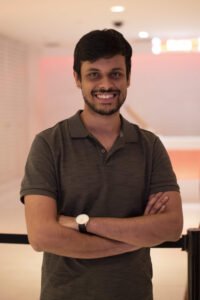Nanotechnology at Northwestern
Meet Prithvijit Mukherjee, a graduate student in the Micro and Nanomechanics Laboratory
June 04, 2021
Prithvijit Mukherjee is a graduate student in Prof. Horacio Espinosa’s Micro and Nanomechanics Laboratory, which focuses broadly on two goals: understanding the behavior of materials across scales, from nano to macro, and developing novel engineered devices for both materials research and biological applications.

Where are you originally from?
I am originally from West Bengal, India.
Where did you complete your undergraduate degree?
I completed my undergraduate degree in mechanical engineering at the Birla Institute of Science and Technology, Pilani which is in Rajasthan, India.
When did you first become interested in theoretical and applied mechanics?
During my undergraduate studies, I was involved in research pertaining to computational modeling of complex microfluidic flows. That is when I developed an interest in applying engineering principles to design microfluidics systems. I decided to apply to PhD programs where groups were working on developing microfluidics and bioMEMS platforms, and Prof. Espinosa’s group happened to be one of them. As a result, I applied to the theoretical and applied mechanics program at Northwestern.
How do you explain what you study to non-scientists?
My research is focused on engineering small devices that can perform biopsies on individual biological cells. It is analogous to drawing and analyzing blood from a patient to monitor heath or investigate an underlying disease. Here the same process takes place but at a microscopic scale and on a single cell or small populations of cells.
Our devices have micro and nano scale features (much smaller than the thickness of human hair!) that enable us to trap cells in compartments and draw out tiny volumes of cellular material without harming them. These devices can also be coupled to different kinds of sensors to study the extracted cellular material. Since the cell’s health is not affected by our process, we can repeat the extraction at multiple time-points! Thus, the technology provides a window to peek into the interior of cells and understand how they function.
This has several applications, particularly in studying cellular processes that unfold over time, such as how cell behavior changes in response to drugs or how diseases progress and change a cell’s function.
Your research involves developing BioMEMS platforms for cell transfection and sampling via localized electroporation. What inspired you to focus on that? What are you excited about in your current research?
My main motivation behind pursuing this direction was to be able to contribute towards developing the next generation of tools that enable new biological investigation. BioMEMS and microfluidic platforms are already enabling new directions of inquiry that were not possible a few years ago — for example, single cell RNA-sequencing, which is based on droplet microfluidics. The localized electroporation-based cell sampling platform provides an interesting microfluidics technology that enables assays that do not exist currently and there is huge potential for interesting interdisciplinary work using this technology.
At this point I am using the localized electroporation platform to investigate effects of perturbations on cell differentiation, which is exciting.
What has been a highlight of your time at Northwestern?
At Northwestern I have had the opportunity to interact and collaborate with researchers from several disciplines such as chemistry, biomedical engineering, and neurology, especially through the IIN. This has not only enabled me to learn a lot but has also opened my mind to think about problems from many different perspectives.
What has been the most challenging aspect of your work or your time at Northwestern?
The most challenging aspect was to get acquainted with all of the different fields involved in my interdisciplinary research, ranging from cell and molecular biology to microfabrication and mechatronics. A lot of things were completely orthogonal from my prior experience and expertise. It was a challenging but fun learning experience. Moreover, my colleagues and collaborators have always been extremely helpful and supportive in helping me out with my questions and difficult steps in my research.
Can you tell me about your experiences either being mentored or mentoring others?
In addition to Prof. Espinosa, I was guided by Shiva Nathamgari, who was a senior graduate student in the lab when I had just joined Northwestern. He was very patient, helpful, and always ready to brainstorm ideas and answer my questions, no matter how trivial. My approach towards planning and executing my research was significantly influenced by him. Other than that I also learnt a lot from senior research professors in collaborating groups: Dr. Eric Berns from the Mrksich Lab and Dr. Chian Yu Peng from the Kessler Lab.
Now that I am a senior student in the lab, I enjoy mentoring junior students in all aspects of their research. I try to advise them on relevant coursework, planning of experiments, and technical writings or presentations. I like bouncing ideas off them and engaging in scientific discussions with them. I also encourage them to look at failures in a positive light so that it boosts their confidence. It is always rewarding to see them make progress and succeed in their research.
What are your hobbies outside of the lab?
Outside of the lab I like cooking, watching football games, biking, traveling with my wife, and spending time with my dog, Peanut.